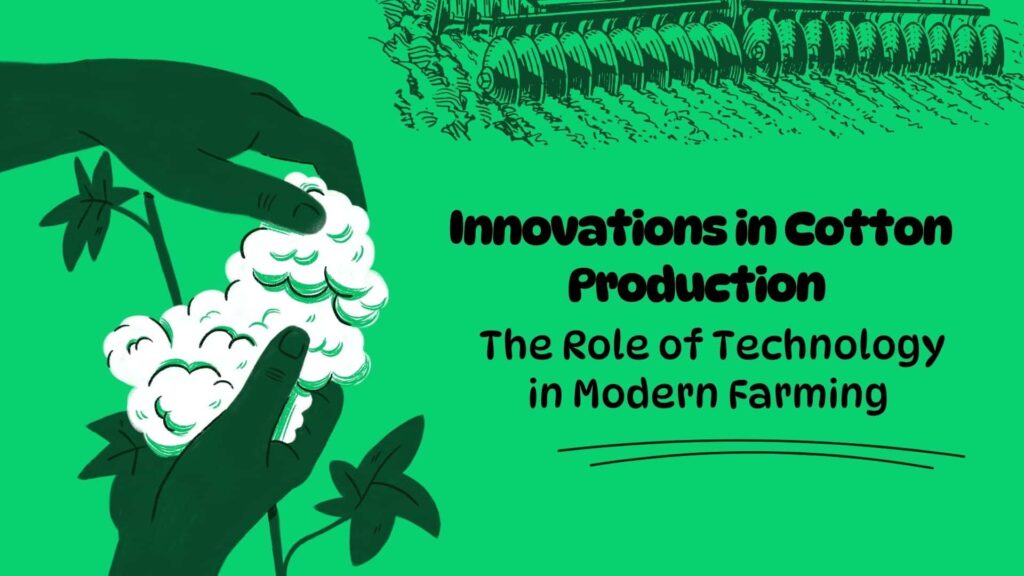Cotton is a vital crop around the world, contributing significantly to the textile industry, agriculture, and the economies of many countries. The demand for cotton continues to rise, creating a pressing need for improvements in how we grow it. At the same time, cotton farming faces challenges like climate change, resource scarcity, and the need for more sustainable practices. To meet these challenges and the growing demand, modern farming has embraced a range of technological innovations. These advancements have revolutionized cotton cultivation, making it more efficient, sustainable, and productive. Just as knitting yarn and knitting wool yarn have gained popularity, the cotton industry is adapting to meet the needs of a rapidly evolving world.
Precision Farming: A Game Changer for Cotton Cultivation
One of the most significant breakthroughs in cotton production is precision farming. This approach uses sensors, GPS technology, and data analytics to manage farming with greater precision at the field level. With these tools, farmers can closely monitor soil health, water levels, and pest activity. By doing so, they can make more informed decisions about planting, irrigation, fertilization, and harvesting. These better decisions lead to higher yields and improved cotton quality.
For example, soil moisture sensors can measure exactly how much water cotton plants need. This helps reduce water waste and ensures the crops get just the right amount to thrive. This technology is especially valuable in water-scarce regions, where efficient irrigation can help conserve resources and save money.
Genetically Modified Cotton for Higher Yields and Sustainability
Genetic modification has also transformed cotton farming. Genetically modified (GM) cotton varieties, such as Bt cotton, have been engineered to resist pests like the cotton bollworm. This reduces the need for chemical pesticides, promotes more sustainable farming practices, and minimizes the environmental impact of cotton production. GM cotton can also be designed to withstand droughts, making it more resilient to unpredictable weather patterns.
In regions where traditional cotton varieties struggled, GM cotton has increased yields and contributed to more sustainable farming methods. While adoption varies across regions due to regulatory, ethical, and market concerns, GM cotton’s potential to revolutionize farming remains immense.
Automation and Robotics: The Future of Cotton Harvesting
1. The Evolution of Cotton Harvesting Technology
Cotton harvesting has come a long way from labor-intensive hand-picking methods. Today, robotic harvesters equipped with AI and sensors efficiently pick cotton, reducing the need for manual labor and improving the harvesting process.
2. Benefits of Robotic Cotton Pickers for Farmers
Robotic cotton pickers offer several benefits. They selectively pick only ripe cotton, leaving unripe bolls behind. This prevents plant damage and ensures cleaner cotton with fewer impurities. The robots also improve consistency and yield, which increases productivity and profitability for farmers.
3. How Automation Reduces Labor Costs and Improves Efficiency
Automation in cotton harvesting cuts labor costs by reducing the need for seasonal workers. These robots work continuously, improving efficiency and ensuring timely harvests. This results in higher-quality cotton and optimized production, allowing farmers to stay competitive in the global market.
Drones: Monitoring Crop Health from Above
Drones have become an essential tool for monitoring cotton crops. Equipped with high-resolution cameras and multispectral sensors, drones fly over fields to capture detailed images and collect data on plant health, water stress, and pest issues. This aerial perspective helps farmers spot trouble areas quickly and take targeted action, such as applying fertilizers or pesticides only where needed.
Drones also provide real-time insights into crop growth, allowing farmers to adjust farming practices and use resources more efficiently. By minimizing the need for broad pesticide spraying, drones help make cotton farming more sustainable and environmentally friendly.
Artificial Intelligence: Optimizing Cotton Farming Decisions
Artificial intelligence (AI) and machine learning are increasingly shaping cotton farming. AI algorithms analyze large volumes of data from drones, sensors, and satellite imagery, identifying patterns and predicting outcomes. These insights enable farmers to make more informed decisions about planting, irrigation, and pest management.
For example, AI can predict potential crop diseases and suggest preventive measures before problems arise. It can also optimize irrigation schedules by considering weather forecasts, soil moisture levels, and plant needs, ensuring that cotton plants receive the right amount of water at the right time.
Sustainable Cotton Farming: A Technological Imperative
As cotton production scales up, sustainability has become more important than ever. Advances in technology help farmers adopt eco-friendly practices. For instance, precision irrigation and integrated pest management systems, along with GM cotton that requires fewer pesticides, are all reducing cotton farming’s environmental footprint.
Blockchain technology also offers a promising solution for improving transparency in cotton supply chains. By creating a digital record of every step in the production process, blockchain helps consumers and companies ensure the cotton they purchase is sustainably and ethically sourced.
Technology has undeniably transformed cotton production. Innovations like precision farming, genetic modification, automation, drones, and AI are ushering in a new era of more efficient, environmentally friendly, and productive cotton farming. As these technologies evolve, they will play an even bigger role in meeting the world’s growing cotton demand while ensuring the industry remains sustainable for future generations.
Farmers who adopt these innovations will be better equipped to stay competitive in an ever-changing agricultural landscape. With continued advancements, the future of cotton production looks brighter than ever. Similarly, as knitting enthusiasts seek the best knitting yarn for handmade clothing projects, using quality knitting yarn will be key to creating beautiful, sustainable textiles.

